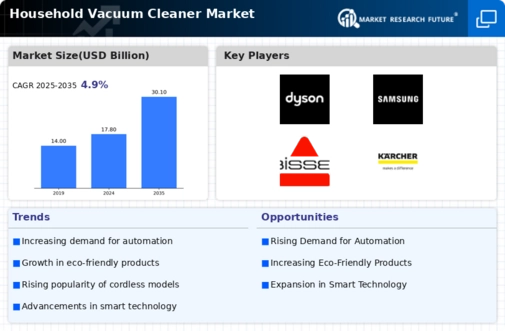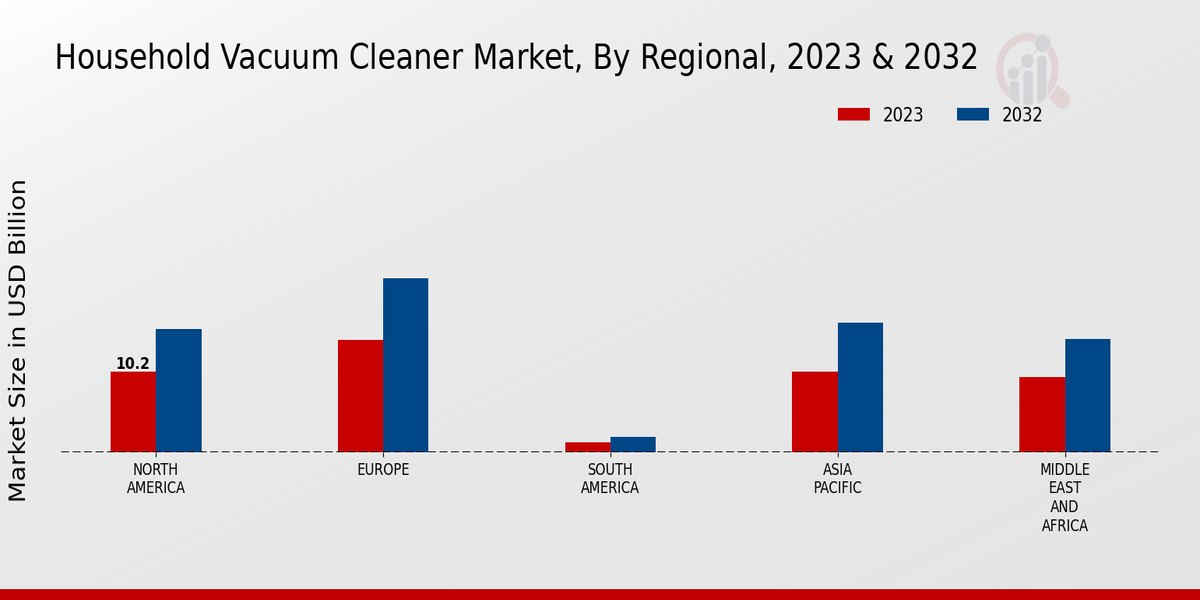Market Growth Projections
The Global Household Vacuum Cleaner Market Industry is on a trajectory of growth, with projections indicating a market size of 17.8 USD Billion in 2024 and an anticipated increase to 30.1 USD Billion by 2035. This growth is underpinned by a compound annual growth rate (CAGR) of 4.88% from 2025 to 2035. Such figures reflect the increasing demand for advanced cleaning solutions, driven by factors such as rising disposable income, technological advancements, and changing consumer preferences. The market's expansion is indicative of a broader trend towards enhanced home cleanliness and hygiene.
Rising Consumer Awareness
The Global Household Vacuum Cleaner Market Industry experiences a notable increase in consumer awareness regarding the importance of cleanliness and hygiene. As households become more conscious of indoor air quality and the presence of allergens, the demand for efficient vacuum cleaners rises. This trend is particularly evident in urban areas where pollution levels are higher. Consumers are increasingly seeking advanced features such as HEPA filters and smart technology, which enhance cleaning efficiency. This growing awareness is projected to contribute to the market's expansion, with the industry expected to reach 17.8 USD Billion in 2024.
Technological Advancements
Technological innovations play a pivotal role in shaping the Global Household Vacuum Cleaner Market Industry. The introduction of robotic vacuum cleaners, which offer convenience and automation, has transformed consumer preferences. Additionally, advancements in battery technology have led to the rise of cordless vacuum cleaners, appealing to consumers seeking mobility and ease of use. These innovations not only enhance user experience but also improve cleaning efficiency. As a result, the market is likely to witness sustained growth, with projections indicating a market size of 30.1 USD Billion by 2035, driven by continuous technological evolution.
Growing E-commerce Platforms
The expansion of e-commerce platforms significantly influences the Global Household Vacuum Cleaner Market Industry. Online shopping provides consumers with convenient access to a wide range of vacuum cleaner options, often at competitive prices. This shift in purchasing behavior is particularly relevant in regions where traditional retail may be limited. E-commerce platforms also facilitate consumer reviews and comparisons, aiding informed decision-making. As more consumers turn to online channels for their household needs, the market is poised for growth, reflecting changing shopping habits and preferences in the digital age.
Increasing Disposable Income
The Global Household Vacuum Cleaner Market Industry benefits from the rising disposable income of consumers worldwide. As individuals and families experience improved financial conditions, they are more inclined to invest in high-quality household appliances, including vacuum cleaners. This trend is particularly pronounced in emerging economies, where urbanization and economic development are driving consumer spending. The ability to purchase premium products with advanced features is likely to enhance market growth. Consequently, the industry is expected to maintain a robust growth trajectory, with a projected CAGR of 4.88% from 2025 to 2035.
Environmental Concerns and Sustainability
Environmental concerns are increasingly shaping consumer choices within the Global Household Vacuum Cleaner Market Industry. As awareness of ecological issues rises, consumers are gravitating towards energy-efficient and environmentally friendly vacuum cleaners. Manufacturers are responding by developing products that utilize sustainable materials and reduce energy consumption. This shift towards sustainability not only aligns with consumer values but also enhances brand loyalty. As a result, the market is likely to see a growing segment of eco-conscious consumers, further driving demand for innovative and sustainable vacuum cleaning solutions.















